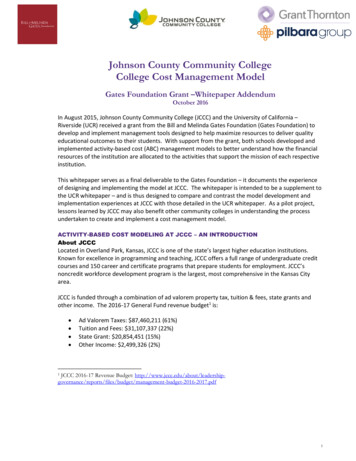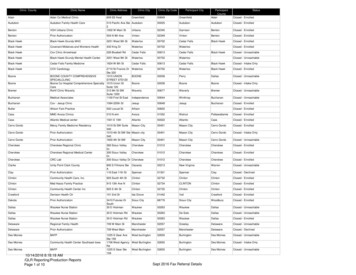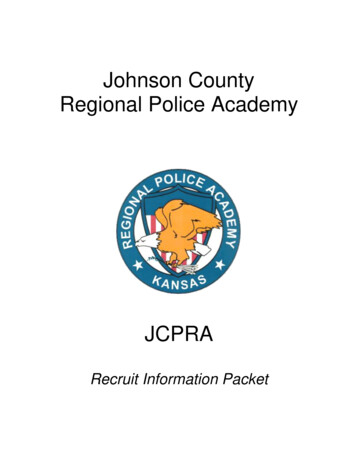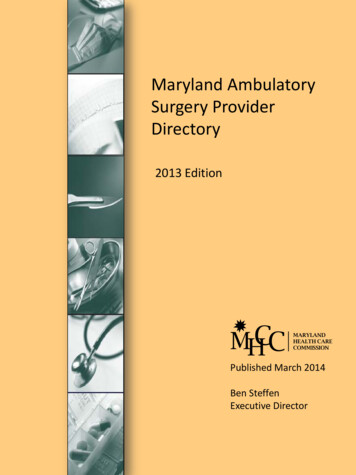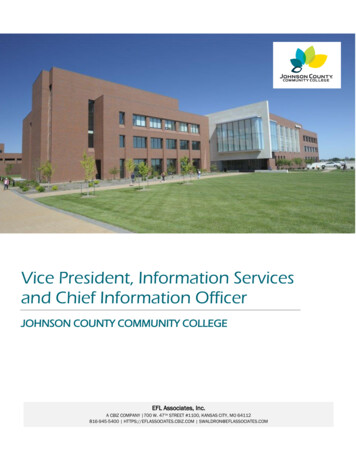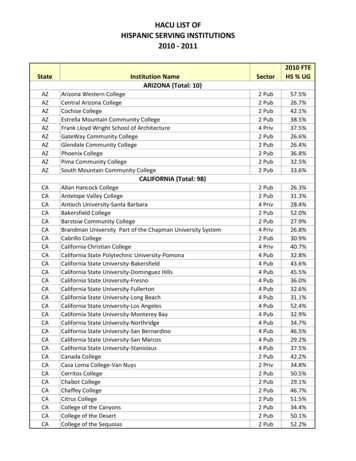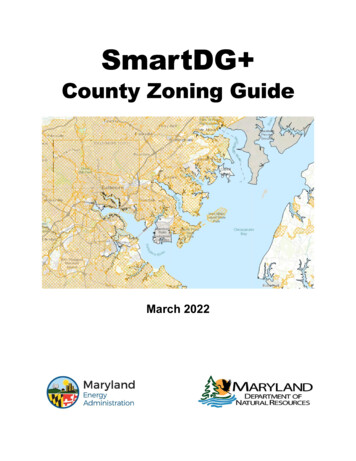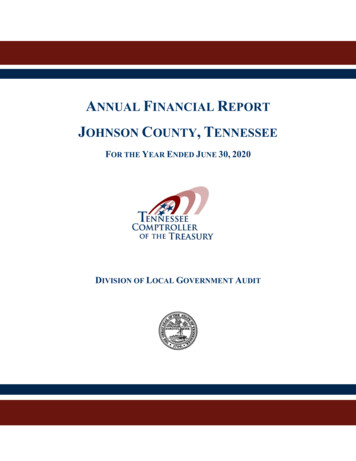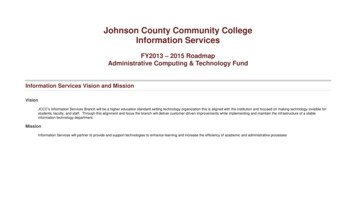
Transcription
Johnson County Community CollegeInformation ServicesFY2013 – 2015 RoadmapAdministrative Computing & Technology FundInformation Services Vision and MissionVisionJCCC’s Information Services Branch will be a higher education standard setting technology organization this is aligned with the institution and focused on making technology invisible forstudents, faculty, and staff. Through this alignment and focus the branch will deliver customer-driven improvements while implementing and maintain the infrastructure of a stableinformation technology department.MissionInformation Services will partner to provide and support technologies to enhance learning and increase the efficiency of academic and administrative processes
Guiding Principles for Technology InvestmentsSupport JCCC’s mission that learning comes first through student success, supporting the college’s innovative spirit, community leadership and continuousimprovement by focusing technology resources on: Creating an environment to promote technology competencyExpanding our network of support services to engage students more actively in the JCCC learning experienceImproving instructional and support activities, utilizing appropriate data and evidenceEmploying technology to improve and deliver quality learning experiencesEnable the greater use of technology to enhance the educational experiences of students, supporting and improving teaching and learningProvide innovative, reliable, secure, flexible for future growth, and cost effective technologies and servicesMaintain and improve JCCC’s position as one of the top digitally-savvy community colleges in the countryPage 2 of 14JCCC Network Infrastructure Plan: Technology FundMar-14
Technology Investment FrameworkMaintenance of underlying infrastructure and systems Re-engineering network infrastructure improvements capable of supporting next-generation campus communications and technologies.Optimizing network performance to address network traffic and data growthStandardize on devices to support redundant design and mobility strategyProtecting and leveraging current technology investments to avoid obsolescenceStrengthening network and system security; implementing necessary policies and technology to promote a safe and secure network environmentAligning with disaster recovery and business contingency planning effortsEnhancement of existing technology, systems and applications Replacing outdated telephone system/lines with IP telephony (voice over IP) in support of call center activities and unified communicationsExpanding campus wireless coverageExtending remote user access to JCCC systems, applications and databasesIncreasing delivery of applications over the web, reducing deployment and maintenanceConsolidating and managing storage of digital contentInnovation of new technologies to advance educational opportunities and improve business processes Enabling mobile user support for college functions/applicationsImplementing virtual wide and local (campus) network and application environments for management and support simplicityImproving workforce effectivenessSupporting expanded collaboration technologies and interactive learning environmentsPage 3 of 14JCCC Network Infrastructure Plan: Technology FundMar-14
Administrative Computing Services and Technology Fund PrioritizationMaintenance of underlying infrastructure and systems Quality of Service: the JCCC wired network was originally designed and built to facilitate the transfer of data and access to the internet. With voice, video, and wireless traffic nowaccounting for a major portion of the traffic due to cloud-based applications and social media, the network infrastructure is being re-engineered to be capable of supporting next-generationcampus communications and technologies. The college’s commitment to the Technology Fund has provided the flexibility needed to move beyond the replacement cycle associated withof a previous era of data network design and implement a cost-efficient, coherent, futuristic, strategy for our college community. Network Performance: The mission of the organization is highly dependent on high-speed, high availability access to network and internet resources. In order to deliver the level ofservice today’s students demand, virtualization is needed at all layers of the campus network (border, core, and distribution layers). Virtual resources are dynamically applied to meetbusiness needs, containing any excess capacity, improving efficiency and availability of the resources. Continued investment in high-performance network technologies that leveragevirtualization and vendor-delivered consolidation. For example, Cisco, NetApp, and VMWare have teamed up to provide an integrated, standardized approach to delivering a fullyvirtualized network and storage solution. 3-year contracts such as these where partnerships are formed provide the college significant cost savings both in hardware and staffing.3-Year Contracts VoIP Infrastructure and Managed Services Network Infrastructure SmartNet Coverage Network Storage Adhoc Wire Pulls Adhoc Fiber Pulls SIP Trunking Redundant Connectivity to Main Campus Remote Site ConnectivityPage 4 of 14CDW-GCDW-GDatalinkDatalink/NetAppR.F. FisherData LinkLevel 3 CommunicationsKanRENKanRENJCCC Network Infrastructure Plan: Technology FundMar-14
Replacement Schedule: Protect and leverage current technology investments to avoid obsolescence (see JCCC Network Infrastructure Inventory document)FY13-16 Network Border, Core, and Distribution Equipment Replacement ScheduleBuildings / LocationCurrent InvestmentFY13CLB, CSB, GYM, HCDC, HCS, Library, Warehouse, WLB 391,860.52*FY14ITC, Nerman, RCFY15GEB, RC 3 Floor and Data Center, Westpark, OCB 3 Floor and Data Center, Police Academy 658,966.35*FY16ATB, CC, COM, CSB, OHEC, SC, SCI, WLB 725,636.35* 1,218,740.63*rdrd*These figures do not yet include the campus-wide wireless network investment or associated maintenance costs for existing network(s) Network and Systems Security: Information Services works directly with Administrative Services to ensure PCI compliance remains a top priority. Business and technology audits areconducted on a regular basis to ensure compliance and track progress. With the PCI compliance checklist as our guide, major improvements have been made to modernize the approachto network and systems security this past year. Traffic is now being separated to provide boundaries, or defense in depth, to protect student and employee data - minimizing risk to theorganization. Wireless network security was revamped this past year with the implementation of Identity Services Engine (ISE), providing an opportunity to collapse the existing wirelessnetworks into one, simplifying management while improving security. Aligning with disaster recovery and business continuity planning efforts: The needs of higher education today require 24x7 network services. A multi-prong approach is needed inorder to inventory and address the network, systems, and application layer services needed to accomplish this goal. Applications are being moved to a hosted or private cloud-basedsolution, depending on the needs of the organization. As a result, an even greater emphasis is placed on network availability and survivability. In response to the college’s changingneeds, efforts are under way to assess the current state of the college’s fiber plant and develop a scheduled replacement cycle to proactively address any issues and prepare the collegefor future growth. Primary objectives for the JCCC fiber build-out include: Page 5 of 14Redundant conduit and dual fiber paths from each building, where possible, to each data centerHigh-availability network services to the JCCC campus community with increased capacity and survivability of the campus network infrastructure, resulting in a highly flexibleand responsive networkImproved remote sites connectivity to main campusJCCC Network Infrastructure Plan: Technology FundMar-14
Enhancement of existing technologies, systems and applications Scalable, Redundant Bandwidth: A second connection to the internet was implemented this past year to provide redundancy in the event of an outage or disruption to our internetservice. Bandwidth utilization has continued to increase as students, employees, and the community use mobile devices across campus. Campus-wide Secure Wireless: Information Services worked this past year to implement wireless throughout the campus and remote locations, providing students, employees, boardmembers, and visitors access to the internet from any classroom, office, or meeting room. This effort was followed up by implementing network access control to provide ubiquitouscoverage while adding a layer of protection to the campus network.JCCC’s new wireless control system allows support staff to centrally manage over three hundred access points throughout campus, providing staff with maps and the ability to drilldown tobuilding floors to monitor access points, coverage areas and number of devices connected. Another advantage to the new system is that it is very dynamic and intelligent, automaticallyadjusting configurations to maintain optimal performance. So if an access point in one area becomes saturated or fails, traffic can be shifted to other areas. Since completing the newsystem, there has been a 50 percent increase in the number of devices connecting to the wireless network, providing students, faculty and staff the mobility they want and need. Internet Telephony (Voice over IP): A migration from the Nortel phone system to the new Cisco VoIP phone solution is nearing completion. Features available in this new systeminclude “soft” phone and “follow-me” capability, providing a graceful mobility solution for JCCC employees. With the implementation of SIP technology, JCCC can take advantage ofInternet telephony on existing data networks, for the benefit of adding available phone lines or call paths during days where the college is experiencing heavy call volumes, providing bettertools for staff and improved services to students. Web Conferencing: The college implemented web conferencing for the classroom several years ago and are now implementing a solution for administrative staff to facilitatecommunication with peers at high schools, colleges and universities, as well as vendor partners. Faxing: The college implemented RightFax in a few office locations where heavy fax volumes are an issue. The RightFax implementation will help streamline processes, improvesecurity, and reduce print costs by delivering faxes via email. RightFax is one of the most recognized fax server platforms on the market for nearly 25 years. A strategy for campus-widerollout is currently being developed.Page 6 of 14JCCC Network Infrastructure Plan: Technology FundMar-14
Innovation of new technologies to advance educational opportunities and improve business processesSourcing StrategySupplementing staff with service provider or managed services relationships in order to support 24x7 campus communications and services.Today’s Challenges: Network and data center systems are mission critical and require an array of specialized technology skill sets Converging technologies and capabilities Increased complexity has changed the way we work Limited resources (financial and human) High expectations of IT from constituents Staffing considerations – partner with KanREN to supplement operations support, skillsets, and monitoring, and serve as a liaison to service providersManaged Services / Cloud Benefits: Risk reduction Address skill gaps Provides contingencies for the college Faster learning curve avoids common pitfalls/resolves faster Speed to value of technology Improved availability & productivity for campus community Optimization of network resources Enable IT to move from “transactional” to “transformational” activities Improved service level and moraleManaged Services: KanREN Consortium Pricing / Negotiation Internet Bandwidth Member Support Liaison w/ Service Providers Remote Site Connectivity Level 3 Call paths using Internet Telephony Bursted call paths to dynamically allocate resources during peak usagePage 7 of 14JCCC Network Infrastructure Plan: Technology FundMar-14
Cloud StrategyTaking advantage of hosted or “cloud” services to facilitate the migration to next-generation technologies and interactive learning environments.Today’s Challenges: ERP and associated systems are mission critical and require an array of specialized technology skill sets Difficulty keeping pace with evolving technologies and capabilities Limited resources (financial and human) Moving away from trying to do everything in-house: focus on value to JCCC High expectations of IT from constituents Staffing considerations /contingenciesHosted / Cloud Services Benefits: Risk reduction Address skill gaps Faster learning curve avoids common pitfalls/resolves faster Customer driven rather than person-dependent Speed to value of software Faster upgrades Optimization of application & database Improved availability & productivity for business users Enable IT to move from “transactional” to “transformational” activities Migrate staffing structure to align with customer-facing / technical approachHosted Services / Cloud Migrations: Benefits Administration (CoolCreek – replaced in-house developed application Code repository / versioning system (GitHub Enterprise) Course and Event Scheduling (Astra) Curriculum Approval and Course Catalog (Courseleaf – replaced CORS) Email Retention and eDiscovery (Gaggle – supports litigation hold process) FY15: Microsoft Exchange – see Sourcing Strategy documentPage 8 of 14 eMarketing Tools (Constant Contact)Emergency Notification System (RAVE)Google Apps for EducationHiring Approval Processes (PeopleAdmin)Payment Gateway and Marketplace (TouchNet)Public Videos (YouTube)JCCC Network Infrastructure Plan: Technology FundMar-14
Network Design StrategyThe Technology Planning Team has served in an advisory capacity as the Infrastructure Technical Team has worked to take steps toward building and maintaining a secure, highperformance, self-healing network.Today’s Challenges: Aging plant / network infrastructure Changes in technology and security requirements Increased demand for technology resources Limited resources (financial and human) High expectations of IT from constituents Staffing considerations – hired network architect to improve quality of both design and operationsBenefits: Reliability 24x7 service to the campus community as appropriate secure network and systems environment for student, faculty, and staff trusted network to provide for cloud and mobility strategies Resilience Supports peak periods of utilization Redundant network core Redundant border firewalls and border routers Redundant KanREN nodes which leverage the college’s diverse fiber paths to campus Interoperability Standardized environment for network and systems administrators to manage Leverages ever-converging technologies and changing marketplace Consistent experience for end-userExamples: Unified Communications Incorporates VoIP, email, chat, web/video conference, to create “presence” and increased productivity Outlook provides status indicator, sharing whether recipient is in / out of the office Voice mail message is retrievable from inbox Move seamlessly from desktop or desk phone to mobile devicePage 9 of 14JCCC Network Infrastructure Plan: Technology FundMar-14
Identity Management StrategyJCCC has implemented Forefront Identity Manager 2010r2 (FIM) to manage identity authentication and account provisioning for the college. The primary objective of this initiative is to transitionfrom a decentralized application approach to a centralized administration approach. Due to the organic progression of the JCCC systems and the natural progression of security constraints, there is currently a very cumbersome and manual interaction to maintainsystem security and provisioning. When processing requests for a hire, termination, or rehire; the process has not always been clear or fully defined. The idea of automation foraccount creation and provisioning helps us completely define the steps required at a business unit level and a organization level. FIM provides not only the technological advances needed to maintain information about each individual that enters and leaves the college, but it also over reaching architecture tointerface with a variety of industry standard technologies. With the implementation of FIM we will now be able to proliferate accounts appropriately through each sub system of thecollege with appropriate rights. Development and deployment of FIM will be a continued effort to refine and change with the growing needs of security and JCCC. Instead of managing these requirements on a persystem basis we will now have a centralized system to manage the life cycle of accounts for each individual. Password Portal for students and employees: The FIM password portal will reduce the need for students to call for help when logging into the portal. Finishing touches are beinginstalled to complete the implementation of a self-service portal for students, faculty, and staff to change their passwords entirely online. In addition to providing a more graceful end-userexperience when changing passwords, this portal will also provide the tools needed to improve the management and administration of access to college technology resources. Examplesinclude, providing students personalized access to the college network, similar to employees, and also help extend the employee 90-day password rotation process to students. Testing iscurrently in progress. Role-based Portal Experience: Human Resources has completed an RFP for an integrated talent management suite which includes an online applicant tracking system, onboardingsolution, online learning management solution, and an online performance evaluation system. Meanwhile, the Student Experience Team is working to modernize the MyJCCC portalexperience for credit and continuing education students enrolling in JCCC courses. Single Sign-On: With a central repository now in place for identities, Central Authentication Service (CAS) is being implemented to create a one-time authentication experience for JCCCemployees and students. This implementation will improve the experience associated with mobile, enterprise, and departmental applications. Rebranding Initiative: The college’s rebranding initiative represents a progression built upon 40 years of tradition. This effort has provided an opportunity to not only revisit businesscards and signage, but also the entire web and systems environments. Information Services has partnered with Marketing and Communications to modernize the college’s web / internetenvironments. A complete website content organization / restructure is planned to begin in FY13 and will help facilitate a pervasive sweep across all web platforms.Rebranding means more than updating the logo, it represents the opportunity to revisit and incorporate the associated user experience from a web, mobile web, and mobile app perspective.Embracing a responsive design approach provides the user an experience relevant and most appropriate for the device(s) they are using real time. This modernized and flexible approachreinforces the college’s mission.Page 10 of 14JCCC Network Infrastructure Plan: Technology FundMar-14
Mobility StrategyThe Student Experience Team has been meeting this past year to guide the development of a mobile and mobility strategy here at JCCC. This team has worked to find a balanced approach thatthe college can afford to sustain. Here are a few of the highlights of the transformation that has occurred this past year: Campus-wide Secure Wireless: Information Services worked this past fall to implement wireless throughout the campus. This effort was followed up by implementing networkaccess control to provide ubiquitous coverage while adding a layer of protection to the campus network. Coverage for courtyards and athletic spaces is currently in progress. Bring Your Own Device (BYOD) Pilot Wireless / Bluetooth devices to help serve the student where they are, translating into shorter lines and wait times for students Teaching and learning outside the classroom (i.e.: hallways, courtyards, athletic spaces) Wireless labs and associated equipment, improved manageability, lab scheduling has become flexible,Mobile Web Site: Information Services Partnered with the Web Systems team to implement a mobile web site presence for the college web site (m.jccc.edu). Administrative Serviceshas been involved throughout the discussion and is now working with IS and TouchNet to implement payment capability via the mobile web site.Mobile Application Platform: Efforts are under way to hire a part-time employee to develop and maintain applications for JCCC’s mobile application platform. Providing applicationsthat integrate with the college’s Banner ERP system is a top priority. CBT View: The Center for Business (CBT) is now utilizing the VMWare View virtual desktop environment for courses in JAVA and Pharmacy Tech. View provides remote desktop capabilitiesin a virtual environment and is currently in use in SMART classrooms and select labs. Virtual desktop technology is fast becoming the accepted standard. Laptops for Continuing Education: The Pharmacology and HiTech programs obtained new classroom laptops. The Pharmacology program received two floating laptops for instructors, andthe HiTech program received 18 laptops plus a storage cart for a mobile classroom. Rave Mobile Implementation: Emergency Preparedness partnered with Information Services to implement the Rave Mobile emergency notification system. Included in the rollout was awelcome email and access to a web-based portal that was distributed to credit students and active employees. Continuing Education students were also included in this rollout although theimplementation is transparent to them, bringing the number of actively enrolled individuals in this emergency notification system up to more than 20,000 and increasing. Notifications will bereceived via email, text, Facebook, Twitter, and desktop alert. TouchNet Mobile and International Wire Transfers: The Business Office, in partnership with Information Services and TouchNet Information Systems, Inc., unveiled the ability for students,employees, and patrons to make payments more gracefully via their mobile device(s). Payment services benefiting from this functionality include: tuition, associated fees, and productsavailable through “Shop JCCC” (https://secure.touchnet.com/C20110 ustores/web/index.jsp). A ‘make payments’ option on the JCCC mobile web site (http://m.jccc.edu/) to access theseservices was made available in December. The capability is delivered via a responsive design approach, which provides the user an experience relevant and most appropriate for thedevice(s) they are using real time.In addition to the mobile payment functionality, the Business Office, Information Services, and TouchNet, are working to provide an option to pay via wire by the end of May. This willespecially benefit JCCC’s international students, in particular those students that come to us from countries with strict regulations regarding currency exchange. Once the functionality isavailable in production, ‘wire transfer’ will appear as a payment method selection within MyFinances.Page 11 of 14JCCC Network Infrastructure Plan: Technology FundMar-14
Enterprise Data StrategyThrough the work of Ellucian and CRM Team Leaders, JCCC has made great strides in maturing enterprise systems and processes. Here are a few of the highlights of the transformation that hasoccurred this past year:Constituent Relationship Management (CRM): The college has made great strides beginning in 2012 to implement a series of custom applications for CE Sales, Prospects, Early Alert, andAdmissions that leverage the college’s Constituent Relationship Management (CRM). For example, the CRM sits beneath the application for admissions and immediately begins tracking thestudent’s basic personal information as they create their account to initiate the application process. This new capability provides front line staff the information they need to reach out to assiststudents as needed. A combined team from Student Success and Engagement and Information Services performed a thorough examination to streamline the process, reducing six applicationsdown to one. Depending on how a student answers questions, they are now presented with additional questions applicable to their circumstances. The new application for admissions can befound at: https://crm.jccc.edu/admissions/Strategy Drivers: The previous vendor-delivered solution was dated and had limited ability to collect information based on the individual or program needs. College Now, selective admissions,and international students filled out separate applications. Asking students to pick a “flavor” of application at the front end of the application process caused confusion for the student and resultedin false starts.Next Steps: Continue to personalize the student experience through messaging and campaigns. Work with areas to improve integration between JCCC processes and base CRM capabilityEllucian Banner Health Checks: In September 2012 the college entered into a five year managed services agreement with Ellucian, the college’s higher education software and servicesprovider. Systems covered under the contract include: Banner, Imaging, Operational Data Store (ODS), Cognos, DegreeWorks, UC4, Evisions, and Workflow. Upon signing the contract, a seriesof health checks began that would ultimately result in a standardized approach to administering these mission critical enterprise applications. Included in that process was the need for daily,weekly, and monthly maintenance windows where work could be accomplished in shorter intervals rather than accumulating upgrades and patches that require multi-day scheduled outages. Thisapproach has not only provided improved availability and productivity for the JCCC community; but has afforded Administrative Computing Services the opportunity to focus more attention onclient support needs.One year later, we were pleased to report that 106 upgrades were applied to the Banner environment, and iterative efforts have been made to standardize overall system configuration, processesand procedures. The Cognos pre-production and production environments have been completely restructured and upgraded, and a similar effort is currently under way for Degree Works, ODS,UC4, and Workflow. JCCCMobile, and International Student & Scholar Management (ISSM) were added to the agreement as of September 1, 2013 and the health check processes for theseenvironments are now complete. Travel and Expense and Banner Document Retention modules were added to the agreement Spring, 2014 with the Luminis student portal being the next area offocus. While much has been accomplished, there is a great deal of effort ahead as we work toward introducing the new BannerXE extensible architecture at JCCC. BannerXE will dramaticallyimprove the user experience and deliver the ability to integrate with the college’s portfolio of vendor partner products. Recognition goes to the JCCC Ellucian Support teams, Team Leaders, andfunctional area Banner experts for their dedication and hard work, and to the campus community for their support as we work to prepare the JCCC Banner environment for the future.Page 12 of 14JCCC Network Infrastructure Plan: Technology FundMar-14
Enterprise Data Warehouse (EDW): JCCC is in need of an enterprise data warehouse (EDW) to store repeatable, synchronized, snapshots in time across all systems. Using an EDW wouldaddress the deficiencies in the current environment and provide an interactive, user-friendly interface for leaders across campus to interact with the data they need in order to make decisions.Strategy Drivers: The current business intelligence (BI) environment consists of an Operational Data Store (ODS) and the Cognos report writer tool that is used for adhoc departmental reportingand data downloads. Enterprise processes such as census day and fixed asset reporting are also managed through the current set of tools by “freezing” Banner data or taking a “snapshot” intime. However, an ODS lacks the ability to provide flexible enrollment analytics, which would require daily snapshots in order to compare: Today vs. yesterdayToday vs. this day last yearAnalyze by age group, program, etc.The current BI environment also lacks the ability to provide trend information across systems – accuracy requires that system wide snapshot be taken at the same time. An EDW would helpprovide: Ability to freeze and analyze data across systemsImproved ability to recognize patternsAutomation – currently manual exercise to build / edit dataPage 13 of 14JCCC Network Infrastructure Plan: Technology FundMar-14
Disaster Recovery StrategyWhile much has been accomplished since the advent of the Tech Fund to achieve business continuity across all operations, the infrastructure is now in place to address disaster recovery.Information Services has partnered with the Technology Planning Team and Information Services Steering Committee (ISSC) to identify high priority systems environments and required recoverytime objectives. These advisory groups will work together to find a balanced approach that the college can afford to sustain. Below are examples of the types of risk mitigation already in placeand those planned for FY15:Campus InfrastructureCampus NetworkWiredWirelessInternetJCCC Data CenterBanner / ERP EnvironmentMessaging EnvironmentPage 14 of 14ImpactHighHighHighHighProbability ofServiceInter
Page 6 of 14 JCCC Network Infrastructure Plan: Technology Fund Mar-14 Enhancement of existing technologies, systems and applications Scalable, Redundant Bandwidth: A second connection to the internet was implemented this past year to provide redundancy in the event of an outage or disruption to our internet service.

